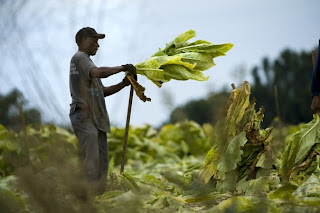"Quitting is hard, but if you can actually do it, there are a lot of benefits that you might not have thought about," said study author Megan E. Piper.
"If you thought you'd have more stress, that quitting would put more stress on your relationships, or that you'll feel worse forever, that isn't the case," said Piper, an assistant professor of medicine at the University of Wisconsin School of Medicine and its Center for Tobacco Research and Intervention.
The findings don't make specify how much of a difference quitting makes in percentage terms. Still, they show a definite gain, she said. Three years after stopping, study participants who had quit reported fewer stressors and improved mood compared to those who continued smoking.
Piper said she and her colleagues wanted to see if they could confirm assumptions about smokers feeling better after they quit and "put some science behind what everybody thinks is true."
Quality of life
One way to do that is to look at how people describe their quality of life. That's tricky, Piper said, since quality of life tends to decline as people age. Even so, the researchers figured they could examine trends over time by comparing people who kept smoking to those who quit.
The study authors looked at the results of surveys of 1 504 people from Wisconsin, 58% women, 84% white - who took part in a smoking cessation study that began between 2005 and 2007. Participants were assigned to one of six groups, some of them using a nicotine patch, nicotine lozenges, the drug bupropion, a combination of those aids or a placebo. All also received counseling to help them quit.
Researchers followed the participants for three years and tested their blood to see if they had actually quit. They also asked about self-regard, standard of living, relationships, friendships and other measures of quality of life.
вторник, 20 декабря 2011 г.
National report shows decreasing teenage use of alcohol, cigarettes
Colorado Attorney General John Suthers said Thursday that a new report from the National Institute on Drug Abuse showing increasing youth consumption of marijuana should be a cause of concern for Coloradans.
According to the 2011 Monitoring the Future Survey, teen marijuana use has increased, most notably among 10th and 12th graders. Among 12th graders, 36.4 percent of those surveyed reported that they had used marijuana at least once within the previous year, up from 34.8 percent in 2010. The 10th graders surveyed also reported a similar increase in use with 28.8 percent of those surveyed reported that they had used marijuana at least once within the previous year, up from 27.5 percent in 2010.
These results tracked parallel to both 10th and 12th graders reporting a lower perception of risk associated with marijuana use. Both demographics reported less perception of risk associated with using marijuana once or twice, smoking marijuana occasionally and smoking marijuana regularly. There is a clear relationship between teenage marijuana use and teens' perception of risk. As the perception of risk of the drug decreases, marijuana use increases.
"These trends are especially concerning given the research on the effects of marijuana use on the teenage brain," Suthers said. "The increasing accessibility and acceptability of marijuana for teenagers in Colorado should be of concern to all of us."
According to the 2011 Monitoring the Future Survey, teen marijuana use has increased, most notably among 10th and 12th graders. Among 12th graders, 36.4 percent of those surveyed reported that they had used marijuana at least once within the previous year, up from 34.8 percent in 2010. The 10th graders surveyed also reported a similar increase in use with 28.8 percent of those surveyed reported that they had used marijuana at least once within the previous year, up from 27.5 percent in 2010.
These results tracked parallel to both 10th and 12th graders reporting a lower perception of risk associated with marijuana use. Both demographics reported less perception of risk associated with using marijuana once or twice, smoking marijuana occasionally and smoking marijuana regularly. There is a clear relationship between teenage marijuana use and teens' perception of risk. As the perception of risk of the drug decreases, marijuana use increases.
"These trends are especially concerning given the research on the effects of marijuana use on the teenage brain," Suthers said. "The increasing accessibility and acceptability of marijuana for teenagers in Colorado should be of concern to all of us."
Marijuana found in charcoal load at Arizona border

Federal officers seized more than a half-million dollars worth of marijuana hidden in a load of charcoal last week.
Last Friday, Customs and Border Protection officers at the Mariposa Cargo facility in Nogales randomly selected a tractor trailer for a non-intrusive inspection.
A narcotics canine was alerted to the presence of drugs inside the shipment, according to CBP.
The truck was off loaded and officers found a false compartment in the front wall which contained 87 bundles of marijuana weighing more than 1,000 pounds.
The 28-year-old Mexican male driver was arrested and turned over to U.S. Immigration and Customs Enforcement's Homeland Security Investigations.
понедельник, 12 декабря 2011 г.
Texas Reduces Amount Allocated To Tobacco Prevention Programmee

Texas is one of the places in the US where children get into smoking from a very tender age, say about 14 years. This has led to a rise in the number of cancer cases and eventually death in young age. Not for once but for many times it has been said that tobacco is one such cause of death in Texas which could be preventable.
In Texas alone, more than 24,000 people die annually, but it seems very little on the part of the state government to be doing something about it. There is no end to revenues which gets generated from tobacco tax or from other tobacco settlements.
But in comparison to last year allocation of money being used on activities that would focus on preventing tobacco use is quite less. As per official figures, more than $1.9 billion is generated for this year but only $5.5 million is allocated for such activities, which is quiet less than the amount that was allocate last year, said James Gray who is Texas Director of government relations for the American Cancer Society.
Tobacco prevention activities are one of the most effective methods to prevent youth from smoking. This fact is not hidden from the state government and then also if they are not encouraging such activities by not spending appropriate fund then they are giving rise to tobacco-related illnesses.
These diseases need lot of money which is not only taxing for patients but also for the state health system. This was the reason that the multistate lawsuit was filed against tobacco giants in 1998.
As per this settlement, tobacco company owners had agreed to pay Texas $15 billion over 25 years as a part of compensation.
All these facts have been added in the study called "A Broken Promise to Our Children: The 1998 State Tobacco Settlement 13 Years Later” which was taken out by number of health institutions.
Report shows slower progress toward reducing teen tobacco use

The Minnesota Department of Health (MDH) released new information this week showing that after a decade of sharp declines in tobacco use among teens, progress is slowing.
In addition, more than 50 percent of high school students are still exposed to secondhand smoke, despite the passage of the Freedom to Breathe Act in 2007. Equally concerning is that the use of menthol cigarettes has more than doubled among teen smokers since 2000. These findings are included in the report, Teens and Tobacco in Minnesota 2011; Results from the Minnesota Youth Tobacco and Asthma Survey.
"We've made great progress in reducing tobacco use since 2000, but the most recent findings in this new report give us little to celebrate," said Dr. Ed Ehlinger, Minnesota Commissioner of Health. "We are failing our youth when you consider that they use tobacco at higher rates than adults and are still being exposed to secondhand smoke. We are setting them up for a future of tobacco-related illness and premature death."
Ehlinger noted that tobacco use continues to be the nation's leading cause of preventable disease and death and that teens are especially vulnerable to picking up the habit. "Too many teens continue to be influenced by the tobacco industry's slick marketing tactics. It is critical that we step up our prevention efforts because 80 percent of adult smokers began when they were under 18," Ehlinger said.
Key findings from the report include:
Between 2008 and 2011, the percentage of middle school students who used any tobacco products in the past 30 days declined from 6.9 percent to 5.6 percent. At the high school level, the percentage declined slightly from 27.0 percent to 25.8 percent. Neither of these decreases is statistically significant. In comparison, 22 percent of adults use tobacco.
Progress in reducing exposure to secondhand smoke has slowed since 2008, after many years of strong declines. Exposure declined slightly between 2008 and 2011, from 55.4 to 52.5 percent for high school students and from 39.6 percent to 37.7 percent for middle school students.
Among high school students, preference for menthols has more than doubled since 2000 and is continuing to rise; 47.3 percent of high school smokers usually smoke menthols today, compared to 39.1 percent in 2008 and 19.9 percent in 2000. Menthol appears to make it easier for young people to start smoking.
One in seven high school students (14.3 percent) report that they have tried snus in their lifetime, and 4.9 percent report using snus in the last 30 days. Snus is a new smokeless tobacco product that comes in small pouches.
More than one-fourth of high school students (28.6 percent) and 6.8 percent of middle school students report that they have tried flavored cigars and little cigars at some point in their lives. (The FDA recently banned candy flavors, fruit flavors, chocolate and other sweet flavors in cigarettes, but not cigar products.)
The percentage of students who see or hear commercials about the dangers of smoking one or more times per week declined significantly between 2008 and 2011 for both middle school students (from 41.2 percent to 31.8 percent) and high school students (from 48.4 percent to 36.0 percent).
The tobacco industry is increasingly active on popular social networking and video-sharing internet sites. One in four high school students (26.3 percent) report seeing videos or clips showing smoking most or some of the time on YouTube or other video-sharing sites, and 20.2 percent report seeing "pages" or "groups" for tobacco products on Facebook.
"This report demonstrates the need to maintain long-term teen tobacco prevention strategies," Ehlinger said. "If we rest on our laurels, we will continue to see our progress slow, or even reverse itself, and we cannot stand for that."
Ehlinger noted a number of strategies that public health officials across the country have used to successfully reduce and prevent youth tobacco use, including:
Price increases on tobacco products.
Counter-advertising mass-media campaigns that include TV and radio commercials, posters, and other media messages to counter pro-tobacco marketing.
Comprehensive school-based tobacco-use prevention policies and programs, such as tobacco-free campuses.
Community interventions that reduce tobacco advertising, promotions and commercial availability of tobacco products.
Ehlinger said MDH will continue working with partners across the state to explore all strategies for reducing teen tobacco use.
The department's Tobacco Prevention and Control Program administers grants to reduce tobacco use and exposure, works together with the Statewide Health Improvement Program (SHIP) and other community-based initiatives, and collaborates with statewide partners to reduce Minnesotans' exposure to secondhand smoke and to help people who use tobacco quit. In addition to working on multiple fronts to discourage youth tobacco use, the program works with diverse communities to eliminate health disparities caused by tobacco use and exposure.
SHIP, which was included in Minnesota's landmark 2008 health reform legislation, aims to help Minnesotans live longer, healthier lives by reducing the burden of chronic diseases caused by tobacco use and obesity.
Tobacco merchants resent govt apathy
An All Kerala Tobacco Merchants Association meet was held yesterday at Casino Hotel auditorium to discuss the problems faced by the tobacco merchants.
Association president K Venkitachalam said, "The government is doing wrong to more than two lakh dealers in Kerala by conducting illegal raids at shops selling tobacco."
It's been one year since this association was formed and problems are ever increasing, he said. The government is collecting taxes on tobacco and seizing the same material stating that a minimum distance of 400 metres should be maintained from schools.
This kind of action should be reverted, he pointed out. "We have given petitions to the chief minister and the deputy general of police," said Venkitachalam.
Also present at the event were Vyapari Vyavasayi Ekopana Samithi state president T Nasurideen, secretary Dr M Jayaprakash, Youth Wing state president Sijo Chirakkekaren, Thrissur city unit secretary Jaison Erinjery, Jacob Varghese of ITC and Kozhikode secretary Sethumadhavan.
Association president K Venkitachalam said, "The government is doing wrong to more than two lakh dealers in Kerala by conducting illegal raids at shops selling tobacco."
It's been one year since this association was formed and problems are ever increasing, he said. The government is collecting taxes on tobacco and seizing the same material stating that a minimum distance of 400 metres should be maintained from schools.
This kind of action should be reverted, he pointed out. "We have given petitions to the chief minister and the deputy general of police," said Venkitachalam.
Also present at the event were Vyapari Vyavasayi Ekopana Samithi state president T Nasurideen, secretary Dr M Jayaprakash, Youth Wing state president Sijo Chirakkekaren, Thrissur city unit secretary Jaison Erinjery, Jacob Varghese of ITC and Kozhikode secretary Sethumadhavan.
Shook Hardy loses part of its tobacco practice

Part of Shook Hardy & Bacon’s famed tobacco practice is moving to a different law firm.
Hughes Hubbard & Reed, a New York-based firm, will open a Kansas City office to assume Shook’s defense work for Lorillard Tobacco.
Kansas City-based Shook retains Philip Morris USA, the industry’s dominant tobacco company best known for its Marlboro brand.
Industry insiders said the move reflected tobacco companies’ desire to be represented exclusively by their outside law firms rather than have a firm also represent an industry rival.
Lorillard and Philip Morris recently have taken different stances on how to respond to tighter regulatory controls by the Food and Drug Administration.
Eight Shook lawyers — six partners and two of counsel to the firm — will move to the Hughes firm, effective Jan. 1.
Hughes will open in the 2345 Grand Blvd. building, about a block from the Shook office tower at Crown Center.
Shook managing partner John Murphy said 17 or 18 staff members also would make the move. The firm did not name the lawyers who will follow the Lorillard business.
It will take until about June 30 for Shook to completely wind down all of its Lorillard work, Murphy said.
The move of Lorillard, which makes Kent, Newport and other cigarette brands, was first reported online by Am Law Daily.
Murphy said Shook had been successful at trial in representing Philip Morris in “significantly more cases” than Lorillard. He declined to compare or quantify the size of the business that Shook did with the two tobacco giants.
Shook’s size and reputation have grown over the years partly because of its products liability litigation work for tobacco companies.
This will be the first Midwest expansion for the Hughes firm, which also has offices in Los Angeles; Miami; Washington, D.C.; Paris; and Tokyo. It has about 300 lawyers in all.
Подписаться на:
Сообщения (Atom)